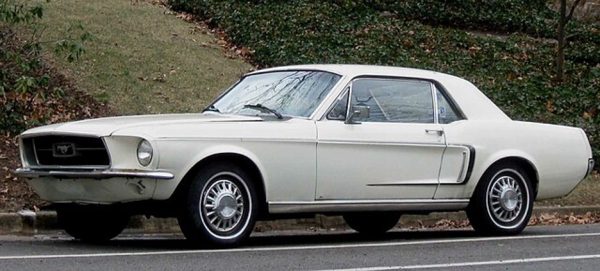What symbolizes the United States to you? If you are architecturally inclined, you might think of the White House. If you like food, you will probably be reminded of McDonald’s or a traditional apple pie. If you enjoy listening to music, the likes of Elvis Presley or even Taylor Swift may come to mind. And if you are interested in cars, then the first thing that you visualize could be the Ford Mustang — the muscle car that has graced the roads since 1964.
In April, Ford Motor Company marked 60 years of manufacturing the Mustang. A “muscle car” that has served as a rival to the Chevrolet Camaro and the Dodge Challenger, this car has become synonymous with America and American living. It has been present in seven generations (not counting the more recent crossover SUV with the “Mustang” nameplate) and immortalized on the big and small screens. Its influence expands beyond the U.S. into global recognition.
History of the Mustang

The Mustang was released to the public on April 17, 1964. Canadian pilot Stanley Tucker was the first individual to own a Mustang after he insisted on buying the first model to roll off the production line. In exchange, Ford Motor Company gave him the one millionth Mustang to be produced in March 1966, less than two years later; Ford’s ability to sell a million Mustang models proved to be a testament to its popularity.
Several versions of the first generation were sold, from the 271 horsepower V8 model to the high-performance Mach 1, Boss 302 and Boss 409 versions sold from the late 1960s to the early 1970s. The second generation was unveiled in 1974, around the same time the U.S. faced a staggering oil crisis. The new generation was designed to be more fuel-efficient than previous Mustangs, but was criticized for its relatively sluggish performance (although the “Cobra II” model gained some popularity). Just four years later in 1978, the third generation Mustang was released on the “Fox-body” platform and proved to be considerably more popular. Production lasted until 1993, when the fourth generation model began production; it spawned a number of high-performance editions from the GT variant and the SVT Cobra R to the 2001 “Bullitt” model.
The Mustang started to become more recognizable to the Gen Z community with the release of its fifth generation in 2004. It was built upon an all-new chassis — the “S197” — but its styling also paid homage to its past iterations. One of the S197’s most famous high-performance variants included the Shelby GT500, which comprised the famous 450-horsepower V8 engine. The sixth generation, known as the “S550,” was unveiled in 2015, and came with a wide range of engines, from the straight-4 EcoBoost to the V6 and the Coyote V8.
The seventh and current generation was released to the public in 2022, and combines its natural performance with modern digital features that enhance its driving experience. In addition, a fully-electric crossover SUV, known as the Mustang Mach-E was released at the turn of the 2020s; while it is said to not be quite as powerful and exciting as the Mustang sports car, Car and Driver describes the most recent Mach-E as “a first-rate electric SUV.”
A popular car in popular culture

Since its inception in the 1960s, the Ford Mustang’s popularity has transcended real life and extended to the big and small screens. The Mustang, regardless of generation, has achieved fame through an appearance in popular culture.
- In the 1968 action film “Bullitt,” Steve McQueen’s character pursued his adversaries using a bottle-green Mustang GT 390 Fastback in what is considered one of film’s most iconic car chases. The sequence lasted nearly 10 minutes and did not have any dialogue, and it contributed just as much to the Mustang’s popularity as it did to the film industry. Even later generations spawned “Bullitt” models designed to resemble the car used in the film.
- In the James Bond film “Diamonds Are Forever” (1971), Sean Connery and his paramour engaged in a chase using her red Mustang Mach 1. Notably, Connery’s character drove the car into a narrow alleyway on its two right wheels and exited on its two left
- In “Charlie’s Angels”, private investigator Jill Munroe (Farrah Fawcett) drove a second-generation Cobra II, which is arguably the car most associated with the show. Although Fawcett quit the series after one season, her on-screen sister Kris (Cheryl Ladd) continued to drive the car for the rest of the show’s run. Meanwhile, Kelly Garrett (Jaclyn Smith) drove a Mustang Ghia, also a second-generation model.
- First-generation Mustangs appeared in both adaptations of “Gone in 60 Seconds”. The model in the 1974 film was built in 1971, and the one featured in the 2000 remake was a 1967 Mustang GT500; both cars were nicknamed “Eleanor.” The latter vehicle became so popular that Denice Shakarian Halicki, widow of the original film’s creator H.B. Halicki insisted that the car was actually a character in its own right. Thus, she tried to prevent any identical models from being manufactured, even taking car builder Carroll Shelby’s estate to court over the matter.
- In “Fast and Furious: Tokyo Drift,” a 1967 Mustang fastback was used by a main character — but the vehicle in the film was actually powered by an RB26 engine swapped from a Nissan Skyline R34.
- In the first “John Wick” installment, the main character (Keanu Reeves) drove a 1969 Mustang Mach 1 (although it was modified to resemble the rare Boss 429 model, and was referred to as such throughout the film).
- In the 2015 “Need For Speed” movie based on the racing games, Aaron Paul’s character, Tobey Marshall, is instructed to restore a Mustang GT500 (erroneously referred to as a Shelby). In addition, a brand-new Mustang was briefly shown at the end, to celebrate the release of the new model.
Additionally, the Mustang has been used in several car racing games. In 2005, “Ford Mustang: The Legend Lives” was made available for the PS2, which included several incarnations of the car from its inception onwards. According to GTA Base, the “Vapid Dominator” car in “GTA V” is based on the Mustang, as it takes on its likeness. More recently, the 2024 Mustang Dark Horse model was featured in “Need For Speed: Unbound.”
The Ford Mustang is an American icon that has garnered global recognition. Its sleek looks and high-performing engines have made it a favorite among car enthusiasts, and its appearances in film and television have contributed to its popularity. As it continues into its 60th year, the Mustang will continue to be immortalized by the manufacturer, media and machine-lover alike.
Kalana Amarasekara can be reached at [email protected].




















